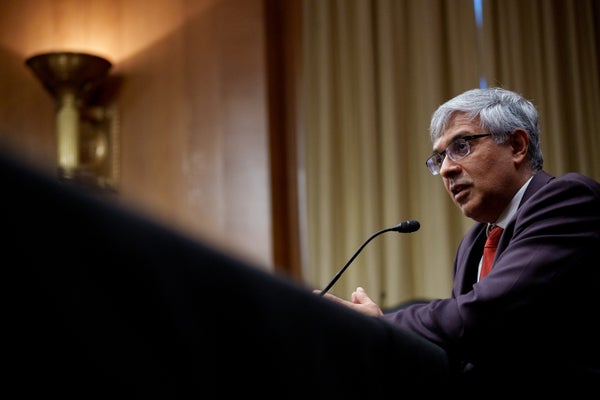
NIH Director Removes Four Main Scientists amid Massive Staff Purge
www.scientificamerican.com
April 1, 20254 min readNIH Director Removes Four Main Scientists amid Massive Staff PurgeThe Trump Administration has fired four leaders and thousands of employees at the National Institutes of Health in "one of the darkest days"By Max Kozlov & Nature magazine Jay Bhattacharya took office as director of the US National Institutes of Health on April 1, 2025. Andrew Harnik/Getty ImagesOn health economist Jay Bhattacharyas first day as head of the US National Institutes of Health (NIH), the chiefs of four of the 27 institutes and centres that make up his agencyincluding the countrys top infectious-diseases officialwere removed from their posts. The unprecedented move comes amid massive cuts to research at the NIH.The directors of the National Institute of Allergy and Infectious Diseases (NIAID), the National Institute of Child Health and Human Development (NICHD), the National Institute on Minority Health and Health Disparities (NIMHD) and the National Institute of Nursing Research (NINR) were informed late on 31 March that they were being placed on administrative leave. Together, these leaders were in charge of US$9 billion in funding at the NIH.At least some directors were offered reassignments to the Indian Health Service, a division of the US Department of Health and Human Services (HHS) that provides medical care to Indigenous people living in the United States. (The HHS is the parent agency of the NIH.) HHS proposes to reassign you as part of a broader effort to strengthen the Department and more effectively promote the health of the American people, reads an e-mail to the directors that Nature has obtained. This underserved community deserves the highest quality of service, and HHS needs individuals like you to deliver that service, it says, offering reassignment to locations such as Alaska, Montana and Oklahoma.On supporting science journalismIf you're enjoying this article, consider supporting our award-winning journalism by subscribing. By purchasing a subscription you are helping to ensure the future of impactful stories about the discoveries and ideas shaping our world today.These large-scale reassignments are unheard of for the NIH, the worlds largest public funder of biomedical research: although the director of the NIH and the director of one of its institutes, the National Cancer Institute, are political appointees chosen by the US president, the other 26 directors of the NIHs institutes and centres are not typically replaced when presidential administrations change. (NIMHD director Eliseo Prez-Stable, for example, had been in his role for nearly 10 years, under three different US presidents.) But US President Donald Trump, who took office in January, has not been following the norms of past administrations during his second presidency.This will go down as one of the darkest days in modern scientific history in my 50 years in the business, says Michael Osterholm, an infectious-diseases epidemiologist at the University of Minnesota in Minneapolis. These are going to be huge losses to the research community.When asked for a response, the NIH directed Nature to the HHS for comment. The NIHs top communications officer, Renate Myles, was also placed on administrative leave, according to an agency staff member, who requested anonymity because they were not authorized to speak with the press. The HHS did not respond to Natures queries by publication time.A consolidation of powerThe removal of the directors follows an announcement last week by HHS chief Robert F. Kennedy Jr that his agency, which includes the NIH, would be reducing its workforce by 20,000 employees, or about one-quarter of its staff members. Layoffs have largely been targeted at administrative staff, but many scientists, including those that run HIV prevention programmes and research have also been affected.The layoffs will challenge the longstanding status that the NIHs institutes and centres have had within the agencyas semi-autonomous entities. Legislative, communications, IT and other administrative workers within each institute received termination notices early on 1 April, a move designed to consolidate power under the NIH director. NIH will cease to function after the RIFs [reductions in force]; it will take months to get things back online administratively, says another NIH official, who requested anonymity because they were not authorized to speak with the press.In his first e-mail to agency staff members on 1 April, which was obtained by Nature, Bhattacharya wrote: These reductions in the workforce will have a profound impact on key NIH administrative functions ... and will require an entirely new approach to how we carry them out.Bhattacharya also wrote that he wanted the NIH to focus on reproducibility and rigour, transparency and academic freedom, even as the agency on 28 March scrapped its scientific integrity policy aimed at prohibiting political influence on government science.Meanwhile, in the past month, the NIH has terminated more than 700 research grants funding studies of an ever-growing list of topics: projects on transgender populations; gender identity; diversity, equity and inclusion (DEI) in the scientific workforce; COVID-19; vaccine hesitancy; and environmental justice.Of these grant cancellations, a disproportionate number come from research funded at the NIAID, the NICHD, the NIMHD and the NINR. These institutes fund many projects that clash with Trumps political ideology, a possible explanation for why these directors were targeted.The NIAIDwhich was being led by infectious-disease physician Jeanne Marrazzo and, before her, by Anthony Faucihas been especially scrutinized by Trump and other Republican politicians for its alleged deficiencies in the oversight of grants funding research on risky pathogens and the SARS-CoV-2 coronavirus. Conservative policymakers introduced a bill in February that proposes dismantling the NIAID and splitting it into three separate institutes.The treatment of these directors is frankly unconscionable, says Monica Bertagnolli, former NIH director under Trumps predecessor, Joe Biden, a Democrat. These are all outstanding leaders, who were let go without accounting for the harm that could be done with the loss of research productivity and the loss of programmes delivering life-saving treatments.This article is reproduced with permission and was first published on April 1, 2025.
0 Commentaires
·0 Parts
·45 Vue


